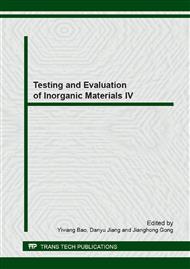p.3
p.8
p.12
p.16
p.20
p.26
p.30
p.34
Raman Spectroscopy Study of YSZ Co-Doped with CeO2/Gd2O3
Abstract:
Phase characterization is critical in material properties probing. In this study, Raman scattering was employed to identify the phase of YSZ co-doped with CeO2/Gd2O3. As a comparing, XRD for co-doped YSZ was also measured. The results show that introducing a small amount of CeO2/Gd2O3 into YSZ can lead to a change on Raman spectroscopy. Raman peaks appear with co-doping is attributed to the local structure change which caused by the re-distribution of vacancy. Comparing to XRD, Raman spectroscopy shows a more sensitive on the phase identify for the YSZ with a small amount dopant.
Info:
Periodical:
Pages:
8-11
Citation:
Online since:
November 2013
Authors:
Keywords:
Price:
Сopyright:
© 2014 Trans Tech Publications Ltd. All Rights Reserved
Share:
Citation:


